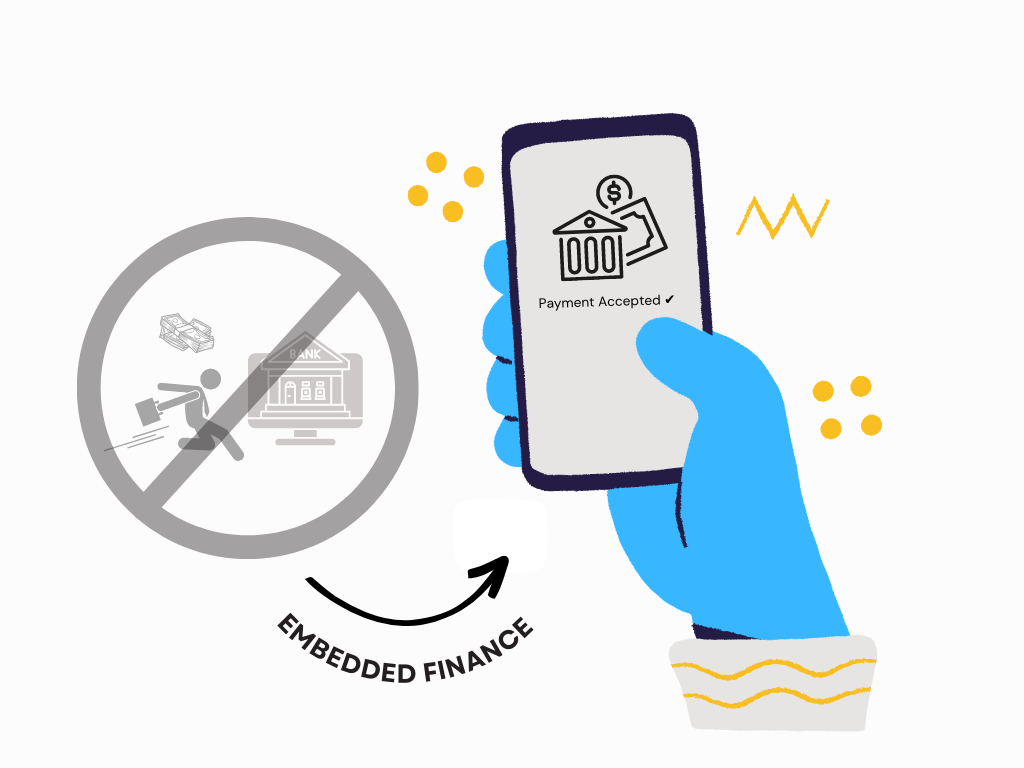What is Embedded Finance And Why is it The Future of Fintech
The embedded finance market is growing rapidly. How exactly do embedded transactions help increase customer satisfaction and revenue?
What Is Embedded Finance?
Embedded finance is the integration of financial services such as lending, payment processing, and insurance into the infrastructures of non-financial enterprises without the need to refer customers to conventional financial institutions.
For businesses, embedded finance expedites the processing of financial decisions. Compared to traditional invoicing, businesses also have better insight into the spending patterns of their clients and get paid more quickly.
Customers who interact with enterprises that use embedded finance systems can complete financial transactions more quickly and easily without having to visit a bank.
The most well-known sort of embedded finance product is arguably embedded payments. Customers may place an order and pay for it all in one application with the help of Amazon, Uber, DoorDash, Walmart, and Instacart, which all support embedded payments.
Other examples of embedded payment programs where users may save bank data and complete transactions in one location are Google Pay, Apple Pay, and Venmo.
As Covid-19 swept the globe, remote working became the norm, and businesses moved from the main street to people’s living rooms. Mobile banking channels saw a 20-50% increase in use. This number is expected to remain high even as the world returns to normal, so we need to discuss fintech.
Fintech is a relatively new concept, combining “finance” and “technology” to improve and automate financial services. Who doesn’t appreciate being able to manage their finances securely from anywhere using everyday electronic devices? Person-centered at heart, fintech is a response to the transformation of consumer behavior.
A boom in alternative banking has changed the competitive landscape completely. Most businesses – from retail banking and investment management to non-profit organizations – are looking into the automation and improvement that fintech strategies offer.
Customers will no longer settle for uncomfortable, complicated journeys through the sales funnel. Hurdles like costly phone numbers or completing a lengthy signup process can cause customers to abandon their journey immediately. That’s why many companies now look for services like “Canada toll-free numbers” or Google Sign-In to make this step easier.
Businesses must provide seamless interactions and allow their clients to manage their finances and business processes easily. Luckily, there’s a straightforward two-word answer to how to achieve exactly that: embedded finance.
Why External Payments are a Thing of the Past
Let’s begin with an example of a customer journey. After falling in love with a product online, the customer puts it in their shopping cart. Perhaps they browse around for a bit, looking for discounts or other things to add. Upon checking out, a window pops up: make payment via bank transfer. Account number, business name, sort code, and all.
Chances are, at this moment, the item about to be purchased gets left behind instead, joining a virtual ghost town of abandoned shopping carts. Your business is lost, and the customer is disgruntled, looking for easier alternatives. Whether you’re a software provider offering the best VoIP in Canada or a charity organization, embedded finance can help you avoid losing money in situations like these.
Understanding Embedded Finance
On the surface, embedded finance is quite a self-explanatory term. Embedded finance stands for seamlessly integrating (or embedding) financial solutions into the services of non-financial companies to simplify the customer journey.
Integrating financial services into non-financial platforms offers companies more economic ownership while also eliminating a lot of paperwork and increasing trustworthiness by conducting business on a safe platform. Outsourcing the security and maintenance of a payment service can help reduce operational costs for your business.

On the customer’s end, embedded finance improves the user experience. It does this by streamlining the financial process, making it quicker, more straightforward, and more accessible for consumers to access from anywhere, at any time.
However, there is more to embedded finance than meets the eye. We’re not just talking about direct payments. Loans, insurance, cryptocurrency, or buy now, pay later methods can all be part of this innovative field.
Embedded Finance in Practice
Embedded finance allows companies to move funds without having to open another app to process the online transaction via a third party (bank).
Let’s have a look at how embedded finance eliminates the gap between the company and its customers by streamlining financial processes in practice.
1. Embedded payments
Embedded payments are perhaps the most obvious, day-to-day example of embedded finance. Just as nobody carries cash anymore, embedded payments may soon become the new normal, replacing the need to switch between apps to make a purchase or having to re-enter card information every single time.
Forget looking for an ATM or hastily digging out a credit card - embedded payment methods offer the addictive luxury of paying directly within the app. A great example of this is ride-sharing services, such as Uber, Lyft, or TappCar, where transactions are completed in a seamless manner without ever leaving the app.
Something as simple as saving your customer’s card details can make you stand out among competitors who aren’t as up-to-date technologically.
2. Embedded card payments
Another way to streamline payments is by using embedded cards. Embedded cards are a great option for companies, simplifying the process of making payments while avoiding interchange fees. A common example of this is PayPal which allows users to spend from their PayPal account rather than a bank account or card.
For customers, embedded card payments offer more protection from fraud and misuse, along with the added bonus of convenient use and different options of payment methods.
If your company decides to look into offering embedded card payments, make sure to have a dedicated customer support team to troubleshoot any issues. Look up international call providers to research the best options so that your clients or employees always have somewhere to turn to in case of emergency.

3. Embedded lending
Instead of going through a grueling process of applying for a loan, financial hardship can now be tackled in a few clicks, benefiting both customer and business. Embedded lending services (such as Klarna or AfterPay) offer an option of splitting a payment into manageable pieces payable across a few weeks or months.
The pros of such services are easy to identify – embedded lending brings simplicity to the otherwise lengthy task that is borrowing money. Without involving a third party or requiring lots of confusing paperwork, all the advantages of embedded lending come together to boost customer engagement and retention.
4. Embedded insurance
Digital consumer behavior is inspiring changes in many areas, and insurance is not lagging behind. It is now commonplace to offer insurance embedded into digital platforms - apps, websites, marketplaces, you name it.
For instance, you may be looking for a new laptop and stumble across a website that offers just what you need, with an added bonus of accidental damage protection. You quickly realize such added service will save you a lot of trouble, and you’ll gladly pay a little bit extra for peace of mind, sorted in minutes and all in one place.
Integrating embedded insurance into your business can help you save on acquisition costs, promote a drastic increase in sales, as well as lower your cost per sale. To keep your financial reporting cycle spotless and ensure data safeguarding, look up “what is SOX controls” and see if you need to make any changes to reduce your risk of data theft.
5. Embedded investment
Embedding banking options can be a great way of making investing more accessible to the public.
Transferring money, keeping track of the financial portfolio, security concerns… Truth be told, investing can be quite daunting to start with. Embedded investment platforms take many of these worries away by simplifying and automating the process.
Improved customer experience is a common denominator of all types of embedded finance. In embedded investment, customers can save time by avoiding moving money between accounts and products. A well-made app can be a trustworthy place, increasing customer loyalty, and revenue.

Embedded Finance: Why You Should Believe the Hype
With the market adapting to digital consumer behavior, embedded finance is inevitable.
Now that you have an idea of what the term stands for, you might be wondering if it’s really worth venturing into. Why not discuss your thoughts with your team?
Change may seem risky, but you can rest assured that this growing market comes with many advantages, such as:
1. Improved end-user experience
Modern humans are creatures of comfort. Something we once settled for, such as entering card details externally to pay for a service, is now unacceptable. Personalization and intuitiveness are the new normal, and embedded finance unlocks the door.
2. Bringing new revenue streams
Embedded finance features can be an easy way of earning extra money for every transaction – such as by offering partners and customers prepaid cards or wallets.
3. Being a source of data
Needless to say, whichever type of embedded finance your company offers, you can use it to gather valuable information about your customers and their behavior.
4. Increasing conversion rate
The more convenient it is to make purchases on your app or website, the more likely they are to happen! Just keep the words ‘intuitive’ and ‘quick’ in your head while implementing new payment options.
5. Promoting customer loyalty
Whether it’s the approachableness of buy now, pay later options or the enticing seamlessness of embedded payments, embedded finance decreases the chances of your customers leaving for alternative providers.

Conclusion
In an increasingly digital world, we are seeing a boom in mobile banking and virtual interactions. The embedded finance market is a direct result of these developments, with its value estimated to grow by $95 billion within the next four years.
Embedded financial products put the customer first by making business interactions quicker and more accessible.
Taking the fuss out of financial transactions pays off in many ways. From increased customer loyalty and satisfaction to increased revenue and lowered business costs, embedded finance has so much to offer — so what are you waiting for?
Jenna Bunnell - Senior Manager, Content Marketing, Dialpad
Jenna Bunnell is the Senior Manager for Content Marketing at Dialpad, an AI-incorporated cloud-hosted unified communications system that provides valuable call details for business owners and sales representatives. She is driven and passionate about communicating a brand’s design sensibility and visualizing how content can be presented in creative and comprehensive ways. Here is her LinkedIn.
Free Resources
To continue learning and advancing your career, check out these additional helpful WSO resources:









or Want to Sign up with your social account?